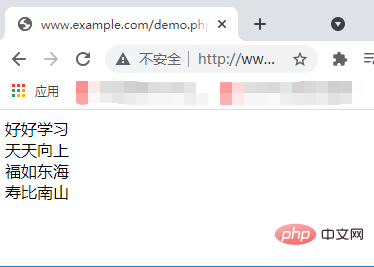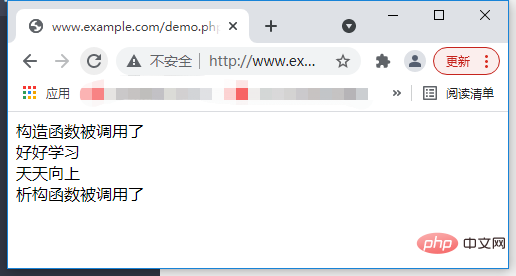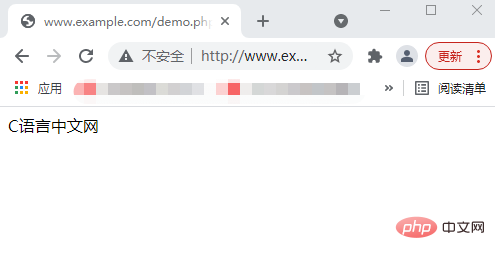Let you distinguish the constructor and destructor in a class
In the previous article, I brought you "How to instantiate objects and access object members in PHP? ", which introduces in detail how to instantiate objects and access object members. In this article, we will take a look at the constructors and destructors in PHP. I hope it will be helpful to everyone!

The constructor in a PHP class is also called a constructor. When an object is instantiated using the new keyword, it can be automatically called when the object is created. It is the a special function. The corresponding function is the destructor. The role of the destructor is exactly the opposite of the constructor. The destructor can perform operations before the object is destroyed. Then let's take a look at these two functions together.
<strong><span style="font-size: 20px;">__construct()</span></strong>:Constructor/method
In PHP classes, we use __construct() as the constructor of the class. The constructor is the first function that is automatically called in the class when the object is created, and can only exist in a class. A constructor, and it should be noted that if there are parameters in the constructor, then the corresponding parameters also need to be passed in for instantiation.
The syntax format created by the constructor is as follows:
public function __construct(参数列表){
... ...
}It should be noted that the parameter list is optional and can be omitted when not needed. construct is preceded by two underscores __.
The examples are as follows:
<?php
class study{
public $study1, $study2, $study3,$study4;
public function __construct($str1, $str2, $str3,$str4){
$this -> study1 = $str1;
$this -> study2 = $str2;
$this -> study3 = $str3;
$this -> study4 = $str4;
$this -> demo();
}
public function demo(){
echo $this -> study1.'<br>';
echo $this -> study2.'<br>';
echo $this -> study3.'<br>';
echo $this -> study4.'<br>';
}
}
$object = new study('好好学习','天天向上','福如东海','寿比南山');
?>$this in the example represents the currently called object. Output result:

From the above results, we pass the __construct() constructor to call the object created in the class.
<strong><span style="max-width:90%">__destruct()</span></strong>: Destructor/Method
Just mentioned__construct()The constructor function will be called when the object is created. The corresponding function is the destructor. The destructor function is opposite to the constructor function. The destructor function It will only be automatically called when the object is deleted from the memory. There is a garbage collection mechanism in PHP. When the object cannot be accessed, the garbage collection mechanism will be automatically started. The destructor is called before the garbage collection object.
__destruct()The syntax format of the function is as follows:
public function __destruct(){
... ...
}It should be noted that, similar to the constructor, destruct is also preceded by two underscores __;The difference is that the destructor cannot take any parameters.
The example is as follows:
<?php
class Website{
public $study1, $study2;
public function __construct(){
echo '构造函数被调用了<br>';
}
public function __destruct(){
echo '析构函数被调用了<br>';
}
}
$object = new Website();
echo '好好学习<br>';
echo '天天向上<br>';
?>Output result:

It can be seen from the above example that the constructor and The destructor is called at different times. The constructor is automatically called when the object is created, and the destructor is called before the object is collected by the garbage collector.
<strong><span style="max-width:90%">$this</span></strong>:The current object
is in PHP In object programming, after the object is created, in each member method of the object, there will be a special object reference "$this", which is connected with the connector -> Used jointly, specifically to complete access between internal members of an object. An example is as follows:
$this -> 成员属性; $this -> 成员方法(参数列表);
When we access a member attribute in a class, we only need to follow the attribute name. There is no need to add the $ sign. $this can only be used in objects. Without an object, there is no $this.
The example is as follows:
<?php
class Website{
public $name;
public function __construct($name){
$this -> name = $name;
$this -> name();
}
public function name(){
echo $this -> name;
}
}
$object = new Website('好好学习');
?>Output result:

If you are interested, you can click "PHP Video tutorial》Learn more about PHP knowledge.
The above is the detailed content of Let you distinguish the constructor and destructor in a class. For more information, please follow other related articles on the PHP Chinese website!

Hot AI Tools

Undresser.AI Undress
AI-powered app for creating realistic nude photos

AI Clothes Remover
Online AI tool for removing clothes from photos.

Undress AI Tool
Undress images for free

Clothoff.io
AI clothes remover

Video Face Swap
Swap faces in any video effortlessly with our completely free AI face swap tool!

Hot Article

Hot Tools

Notepad++7.3.1
Easy-to-use and free code editor

SublimeText3 Chinese version
Chinese version, very easy to use

Zend Studio 13.0.1
Powerful PHP integrated development environment

Dreamweaver CS6
Visual web development tools

SublimeText3 Mac version
God-level code editing software (SublimeText3)

Hot Topics
 1675
1675
 14
14
 1429
1429
 52
52
 1333
1333
 25
25
 1278
1278
 29
29
 1257
1257
 24
24
 PHP vs. Python: Understanding the Differences
Apr 11, 2025 am 12:15 AM
PHP vs. Python: Understanding the Differences
Apr 11, 2025 am 12:15 AM
PHP and Python each have their own advantages, and the choice should be based on project requirements. 1.PHP is suitable for web development, with simple syntax and high execution efficiency. 2. Python is suitable for data science and machine learning, with concise syntax and rich libraries.
 PHP: A Key Language for Web Development
Apr 13, 2025 am 12:08 AM
PHP: A Key Language for Web Development
Apr 13, 2025 am 12:08 AM
PHP is a scripting language widely used on the server side, especially suitable for web development. 1.PHP can embed HTML, process HTTP requests and responses, and supports a variety of databases. 2.PHP is used to generate dynamic web content, process form data, access databases, etc., with strong community support and open source resources. 3. PHP is an interpreted language, and the execution process includes lexical analysis, grammatical analysis, compilation and execution. 4.PHP can be combined with MySQL for advanced applications such as user registration systems. 5. When debugging PHP, you can use functions such as error_reporting() and var_dump(). 6. Optimize PHP code to use caching mechanisms, optimize database queries and use built-in functions. 7
 PHP and Python: Comparing Two Popular Programming Languages
Apr 14, 2025 am 12:13 AM
PHP and Python: Comparing Two Popular Programming Languages
Apr 14, 2025 am 12:13 AM
PHP and Python each have their own advantages, and choose according to project requirements. 1.PHP is suitable for web development, especially for rapid development and maintenance of websites. 2. Python is suitable for data science, machine learning and artificial intelligence, with concise syntax and suitable for beginners.
 PHP in Action: Real-World Examples and Applications
Apr 14, 2025 am 12:19 AM
PHP in Action: Real-World Examples and Applications
Apr 14, 2025 am 12:19 AM
PHP is widely used in e-commerce, content management systems and API development. 1) E-commerce: used for shopping cart function and payment processing. 2) Content management system: used for dynamic content generation and user management. 3) API development: used for RESTful API development and API security. Through performance optimization and best practices, the efficiency and maintainability of PHP applications are improved.
 The Enduring Relevance of PHP: Is It Still Alive?
Apr 14, 2025 am 12:12 AM
The Enduring Relevance of PHP: Is It Still Alive?
Apr 14, 2025 am 12:12 AM
PHP is still dynamic and still occupies an important position in the field of modern programming. 1) PHP's simplicity and powerful community support make it widely used in web development; 2) Its flexibility and stability make it outstanding in handling web forms, database operations and file processing; 3) PHP is constantly evolving and optimizing, suitable for beginners and experienced developers.
 PHP and Python: Different Paradigms Explained
Apr 18, 2025 am 12:26 AM
PHP and Python: Different Paradigms Explained
Apr 18, 2025 am 12:26 AM
PHP is mainly procedural programming, but also supports object-oriented programming (OOP); Python supports a variety of paradigms, including OOP, functional and procedural programming. PHP is suitable for web development, and Python is suitable for a variety of applications such as data analysis and machine learning.
 PHP and Python: Code Examples and Comparison
Apr 15, 2025 am 12:07 AM
PHP and Python: Code Examples and Comparison
Apr 15, 2025 am 12:07 AM
PHP and Python have their own advantages and disadvantages, and the choice depends on project needs and personal preferences. 1.PHP is suitable for rapid development and maintenance of large-scale web applications. 2. Python dominates the field of data science and machine learning.
 PHP vs. Other Languages: A Comparison
Apr 13, 2025 am 12:19 AM
PHP vs. Other Languages: A Comparison
Apr 13, 2025 am 12:19 AM
PHP is suitable for web development, especially in rapid development and processing dynamic content, but is not good at data science and enterprise-level applications. Compared with Python, PHP has more advantages in web development, but is not as good as Python in the field of data science; compared with Java, PHP performs worse in enterprise-level applications, but is more flexible in web development; compared with JavaScript, PHP is more concise in back-end development, but is not as good as JavaScript in front-end development.




